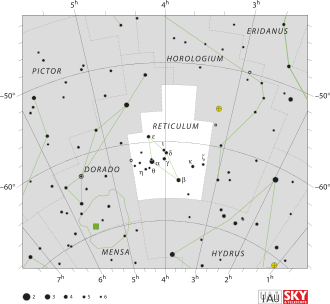| Observation data Epoch J2000.0 Equinox J2000.0 | |
|---|---|
| Constellation | Reticulum |
| Right ascension | 03h 58m 29.55s [1] |
| Declination | −54° 46′ 41.2″ [1] |
| Apparent magnitude (V) | 3.7 - 18.0 [2] |
| Characteristics | |
| Variable type | Nova [3] (sdB?/DA?) [4] |
| Astrometry | |
| Proper motion (μ) | RA: 7.244 [1] mas/yr Dec.: 2.984 [1] mas/yr |
| Parallax (π) | 0.3161±0.0464 mas [1] |
| Distance | 2703+365 −293 [5] pc |
| Other designations | |
| MGAB-V207, YZ Ret, Gaia DR2 4731746232846281344, 2MASS J03582954-5446411 | |
| Database references | |
| SIMBAD | data |
YZ Reticuli, also known as Nova Reticuli 2020 was a naked eye nova in the constellation Reticulum discovered on July 15, 2020. Previously it was known as a VY Sculptoris type object with the designation MGAB-V207.

